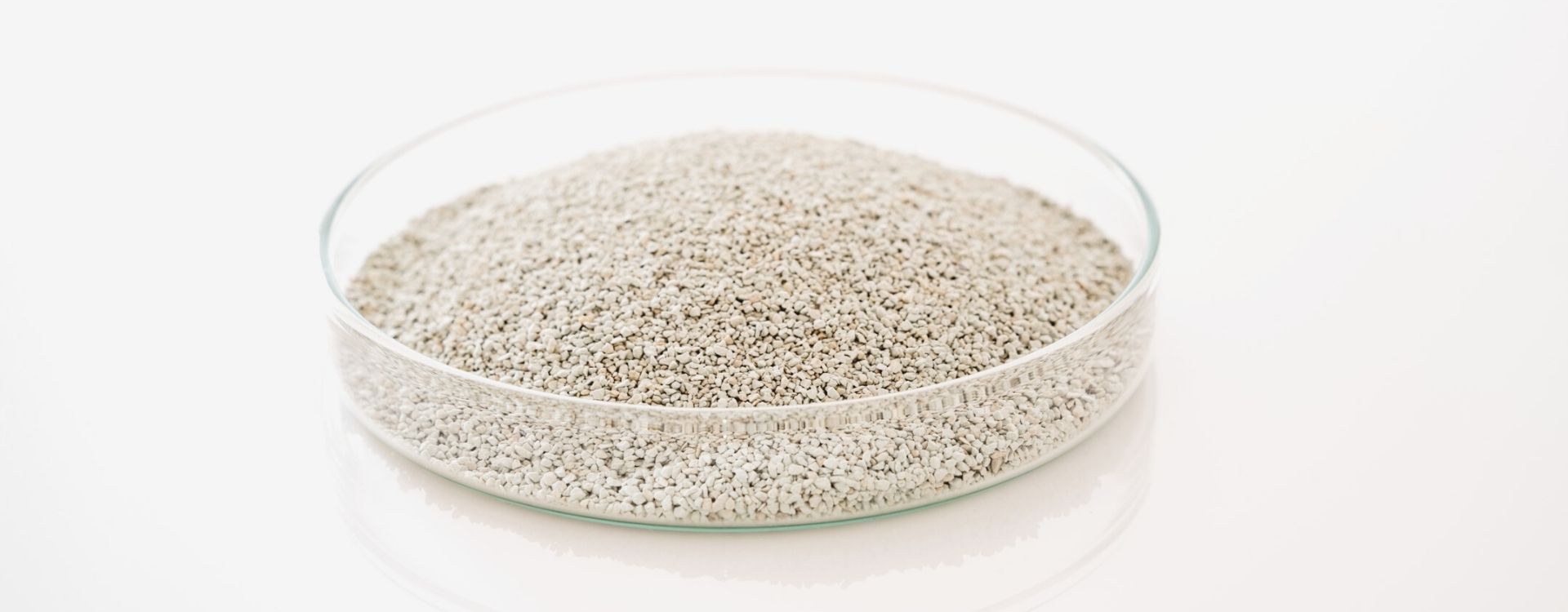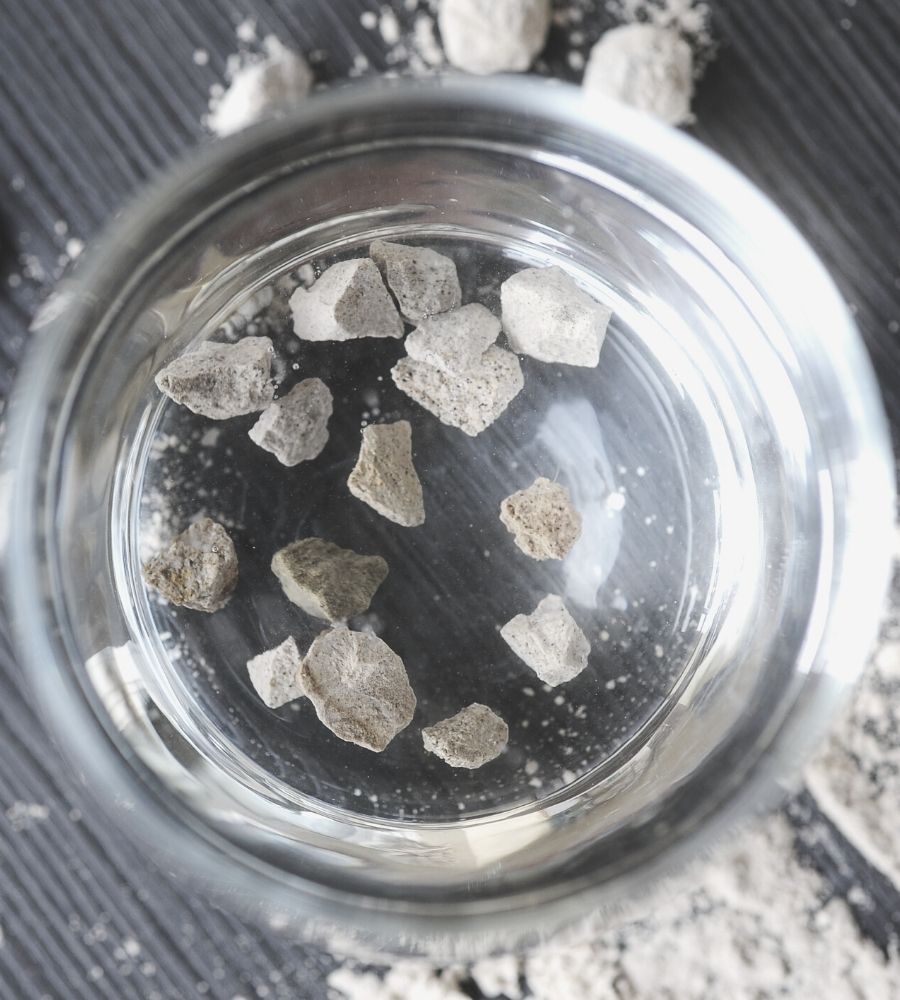

In recent years, the chemical, pharmaceutical, and cosmetic research sectors have shown a strong interest in studying some nano-porous materials and zeolite: but what exactly is this mineral?
It is an aluminosilicate of natural or artificial origin that assumes an open, regular, and microporous crystalline structure, which allows the absorption of gases, metals, and other molecules and facilitates the exchange of ions.
The peculiar structure of zeolite is defined as a sort of “molecular sieve” because of its multiple functions and biological applications, such as strong absorption, radiation protection, decontamination, and detoxification. In addition, it possesses the ability to introduce mineral substances beneficial to the human body by ion exchange. (1)
Zeolite, first formed more than 300 million years ago, has numerous variations. Some of these, for example, were developed by the reaction of volcanic rocks and ash with seawater; still, others are variations created by freshwater.
In nature, zeolite is found in some terrestrial cavities located in areas of ancient volcanic activity. In Australia, for example, there is thought to be one of the oldest deposits in the world.

Zeolite is associated with numerous benefits in various fields and areas: in fact, extensive uses are documented in the medical, pharmaceutical, cosmetic, agro-industrial, and zootechnical sectors, to list a few examples.
From a biomedical and pharmaceutical point of view, theproperties of zeolite make it an excellent antiacid, antidiarrheal, hypocholesterolemic, antidiabetic, and antimicrobial remedy. They are used in numerous drugs. In addition, some in vitro studies have also shown an adjuvant function in oncological therapies, as it can counteract the proliferation of cancer cells.
The external application of zeolite powder has shown essential benefits in treating skin ulcers, reducing the healing time of wounds and surgical incisions. In addition, it has demonstrated efficacy in the treatment of pathologies such as psoriasis.
In general, it has been observed that patients treated with zeolite, administered both internally and applied to the skin, healed faster and in more significant numbers than those treated only with classical therapies.
This mineral is also used in livestock and agro-industrial fields for its detoxifying properties. (1)
So far, very few studies have focused on the possible applications of zeolite in the cosmetic and dermatological fields. However, they are necessary because the developments that zeolite can bring in these fields are innumerable, considering that our skin represents the main accumulation of toxic substances – such as heavy metals – released by jewellery, polluted air, and water. In the long run, the collection in the tissues of these substances, chemical molecules extremely dangerous for our cells, can lead to the onset of numerous pathologies, such as diabetes, cardiovascular diseases, cancer, cellular senescence, and aging. (3)

The identical cosmetic products have often been shown to contain fair amounts of heavy metals due to mineral pigments in their production process. For example, traces of lead have been found in lipsticks and body care products, mercury in brightening creams, cadmium in kajal, nickel, and arsenic in eyeshadows. Unfortunately, only in some countries are these substances prohibited and controlled by the regulations, while no specific restriction is applied in all the others. 3
Regular application of cosmetic products containing harmful substances can cause severe damage to the body in the long run.
Consumers themselves have shown an increasing awareness in this regard, as evidenced by a market survey conducted in the United States by Mintel Group (The Future of Facial Skincare, 2021). The analysis showed that the majority of adult subjects, or 61-67% of respondents, have a strong interest in the use of products that present a claim linked to an antibacterial capacity of the product, the ability to defend the Pelland blue light, and above all able to protect the body from pollutants present in the urban environment.
The numerous products demonstrate this on the market. That has made valuable properties against environmental aggressions their fundamental value, such as antibacterial serums, creams, and cosmetics with sun protection and even a sort of membrane capable of capturing substances such as pollen, dust, and fine particulate matter (i.e., all those substances deriving from car and motorcycle engines to plants for the production of energy, wood for domestic heating and too many other industrial processes).
In addition, in addition to a general trend of increasing importance given to the health care of one’s immune system that emerged from the beginning of the COVID-19 health emergency (41% of Generation Z and Millennials in the United States), according to a survey conducted by Givaudan 52% of women consider it necessary to take care of the skin microbiome through the use of cosmetic products. (2)
Biofarma Group conducted a study on zeolite collaborating with the University of Udine based on the reasons mentioned above. In addition, it investigated the possible benefits obtainable from using zeolite as a component of cosmetic products for skin care.
Specifically, this investigation looked at the ability of zeolite – inserted in the formulation of a cream – to absorb heavy metals.
A standard reference mix solution of concentrated heavy metals at 1000 ppm was used to ensure each metal’s titration with a reasonable level of accuracy. The metal ions were dissolved in a 2% nitric acid solution.
However, as for the product’s composition, two different formulations have been tested: one consisting of 5 grams of cream containing 0.05 grams of zeolite (1% formulation); another of 5 grams of cream containing 0.15 grams of zeolite (3% formulation). All other components have been kept constant in both formulations.

The two formulations were then tested in parallel with a placebo to verify first the absorption capacity of the heavy metals in the standard solution and secondly if this capacity was proportional to the amount of zeolite contained in the formulation (1% and 3%).
The preliminary study demonstrated important nickel and cadmium absorption performance by the 3% formulation.
However, subsequent verifications have shown that the efficiency of zeolite in the removal or filtration of contaminants depends on several factors, including the composition of zeolite, pH, the types of pollutants present, and their concentrations.
In conclusion, the study highlighted how the use of zeolite in cosmetic products could play an essential role in the absorption and removal of heavy metals resulting from the interaction of the skin with environmental circumstances and with certain substances.
Although this preliminary study has yielded significant results, suggesting these benefits of zeolite applied to cosmetics, further research will be necessary in vitro and in vivo to explore this mineral’s potential and approval on human health. For example, it may be helpful to investigate new combinations of zeolite and other absorbent active ingredients to create a better product suitable for the multiple needs of consumers.
In addition, different formulations would allow the creation of products suitable for other clinical applications, such as the use of the mineral for better and faster wound healing, the facilitation of blood clotting, and skin regeneration. (1)
Pesando M., Bolzon V., Bulfoni M., Nencioni A. and Emanuele Nencioni E.; “Exploring the Adsorption Properties of Zeolite in a New Skin Care Formulation”; Cosmetics 2022, 9, 26.
Jindal S., “The Future of Facial Skincare: 2021”; Mintel Group Ltd.
Neag E., Stupar Z., Torok A. I., Ionut Surupaceanu I., Senila M., Cadar O.; “Exploring the Properties of Micronized Natural Zeolitic Volcanic Tuff as Cosmetic Ingredient”; Materials 2022, 15, 2405.
